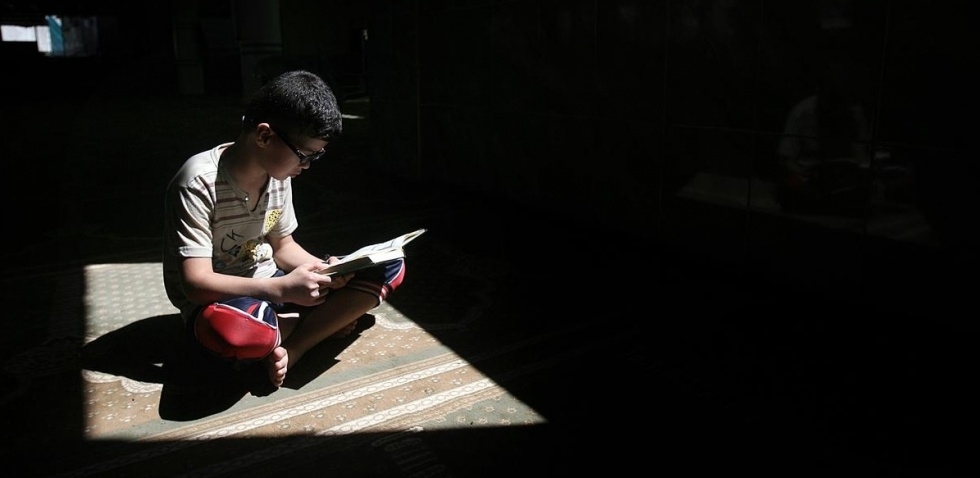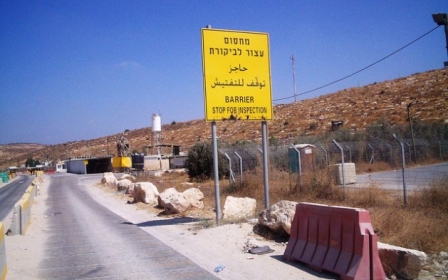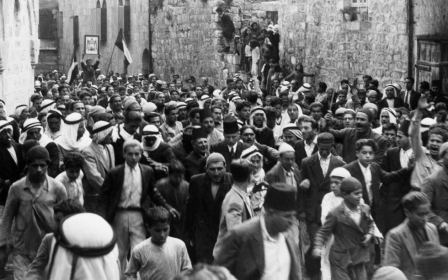
Stealing Palestine: A study of historical and cultural theft
Stealing and appropriating the culture and history of indigenous peoples is a typical characteristic of all modern colonial-settler states, but usually accomplished once the indigenous people in question has been eliminated, dispossessed, or otherwise seemingly defeated therefore making it safe to do so. The colonial-settler state of “Israel,” established on the ruins of Palestine and through the expulsion of the majority of its indigenous population in 1948 and after, is no different.
The Israeli theft of all things Palestinian, however, does not simply come from misguided notions of nationalism or childish pride as is often argued by Western apologists, but is rather a conscious political policy of the state that seeks to erase Palestine from historical memory, particularly within Western discourse. Indeed, the continuing ethnic cleansing of Palestinians from their historic homeland goes hand in hand with the theft of Palestinian land, homes, history, and culture. It is an essential part of the larger, long-term Zionist project of eradicating the Palestinian nation altogether, literally writing it out of history while simultaneously assuming its place.
This erasure has been correctly termed as memoricide by historian Ilan Pappe in The Ethnic Cleansing of Palestine. Nur Masalha, elaborating further, writes: “The founding myths of Israel have dictated the conceptual removal of Palestinians before, during and after their physical removal in 1948... The de-Arabisation of Palestine, the erasure of Palestinian history and the elimination of the Palestinian’s collective memory by the Israeli state are no less violent than the ethnic cleansing of the Palestinians in 1948 and the destruction of historic Palestine: this elimination is central to the construction of a hegemonic collective Israeli-Zionist-Jewish identity in the State of Israel” (The Palestine Nakba, 89).
Thus, the theft of Palestine and its culture has two essential and interwoven components, the removal/erasure of Palestinians and a concurrent assumption of nativity or “birthright” in Anglo-European Zionist terms. Over the last six and a half decades, this brazen erasure and theft has been achieved mainly through two methods: brutal violence (that is, terrorism) and mass media propaganda.
Al Nakba: Physical Destruction/Physical Theft
Between 1947 and 1949, at least 800,000 Palestinians, comprising the majority of the indigenous Arab population of Palestine at that time, were ethnically cleansed from their homes by Zionist militias made up of European and Russian colonists and aided by British imperialists. Major urban Palestinian centres from the Galilee in the north to the Naqab (renamed “Negev” by Zionists) in the south were emptied of their original inhabitants. During this three-year period alone, some 531 Palestinian towns and villages were also simultaneously ethnically cleansed and then later razed by the newly established Israeli state. As Moshe Dayan, a native of the Ukraine, would later boast:
"Jewish villages were built in the place of Arab villages. You do not even know the names of these Arab villages, and I do not blame you because geography books no longer exist, not only do the books not exist, the Arab villages are not there either. Nahlal arose in the place of Mahlul; Kibbutz Gvat in the place of Jibta; Kibbutz Sarid in the place of Huneifis; and Kefar Yehushu'a in the place of Tal al-Shuman. There is not one single place built in this country that did not have a former Arab population" (Ha’aretz, April 4, 1969).
What is perhaps lesser known is that during this same period tens of thousands of books, paintings, musical recordings, furniture, and other artifacts were also looted by the Zionist militias from Palestinian homes, libraries, and government offices. As documented by Benny Brunner and Arjan El Fassed in their film The Great Book Robbery, at least 70,000 Palestinian books were stolen from their owners. As shown in the documentary, this theft was no mere accidental by-product of war; rather, it was a deliberate act with a specific purpose:
“For decades Zionist and Israeli propaganda described the Palestinians as ‘people without culture.’ Thus, the victorious Israeli state took upon itself to civilise the Palestinians who remained within its borders at the end of the 1948 war. They were forbidden to study their own culture or to remember their immediate past; their memory was seen as a dangerous weapon that had to be suppressed and controlled.”
1948, however, would not be the last time that Israeli forces would steal and destroy Palestinian books and other cultural productions. In 1982, during its occupation of Lebanon, Israeli invasion troops would storm the homes, offices, and libraries of Palestinians and walk away with thousands of books, films, and other records documenting Palestinian history. This is a common practice of Israeli occupation forces and continues to this day, most notably in the West Bank, Jerusalem, and Gaza, which were occupied in 1967 along with Syria’s Golan Heights and Egypt’s Sinai.
The meaning behind this theft is not complicated. Unable to assimilate actual, recorded Palestinian history (which was and remains mostly in Arabic) into its fabricated history, Israel chooses simply to destroy it, to physically remove it from sight, while simultaneously inventing and disseminating a fairy-tale account of Palestine as a virgin “land without people for a people without a land.” Consequently, the destruction of Palestinian villages, the ethnic cleansing of Palestinian cities, the aerial bombing of Palestinian refugee camps, and the looting of Palestinian books all lead to the same intersection: what cannot be absorbed within Zionist mythology must be eradicated.
Palestinian Artifacts: Re-writing History
The Zionist belief that modern European and Russian Jews (and all of worldwide Jewry for that matter) are somehow the direct, lineal descendants of ancient Hebrew-speaking tribes who lived on another continent some 2000 years ago and can thus lay claim to Palestine, its history, and its culture would be outright laughable if the political consequences of this fairy-tale ideology were not so tragic. That this racist belief, propagated by both anti-Semites and Zionists alike, is accepted as self-evident truth and not even worthy of questioning by most Western mainstream media outlets is certainly a testament to decades of Zionist propaganda and to a shameful journalistic laziness and conformity of thought that has now become the norm.
A typical example is this article from the Huffington Post titled “Israel Ancient Jewelry Uncovered in Archeological Dig.” According to the article, “Israeli archaeologists have discovered a rare trove of 3,000-year-old jewelry, including a ring and earrings, hidden in a ceramic jug near the ancient city of Megiddo, where the New Testament predicts the final battle of Armageddon.” Based on the guesses of Israel Finkelstein, who co-directed the dig, “the jewelry likely belonged to a Canaanite family.” That may well have been so, but the unquestioned assumption throughout the piece is that this jewelry is in some way Israeli. (Note, as well, how a biblical tale associated with the ancient Palestinian city of Megiddo is mentioned as if this was of any relevance.)
In 1919, the World Zionist Organisation officially presented a map of its future state of “Israel” at the Paris Peace Conference. This map included not only all of Palestine, but also southern Lebanon, southwestern Syria, including the Golan Heights, significant parts of western Jordan, and parts of Egypt’s Sinai. Let us for argument’s sake say that the WZO’s colonial wish was granted at least in the case of Lebanon. Would that make all the ancient artifacts found in occupied southern Lebanon, “Israeli”? What of Syria’s Golan which remains occupied today; are the artefacts found there today somehow “Israeli”? And what about Egypt’s Sinai, a territory that Israel occupied from 1967 to 1979; were the ancient relics discovered there during the period of occupation “Israeli”? And did they stop becoming “Israeli” after the Zionist state properly returned the stolen land back to Egypt?
Since all of Palestine is as stolen as the once occupied Sinai and the currently occupied Syrian Golan, what exactly is so “Israeli” about this ancient jewelry discussed in the Huffington Post article besides the unsubstantiated claims of its author who completely ignores Palestinian history? The European/Zionist re-writing of ancient Palestinian history is so blatant, so ubiquitous, it is almost invisible. Not only have Zionists re-written Palestinian history, they have also written themselves into it even as they remove indigenous Palestinians both physically and notionally out. Wielding history as a weapon, this type of propaganda utilises the laziest and most common form of censorship, that of simple omission.
This particular form of cultural theft, however, is not limited to Palestine. Israel, against all historical evidence, continues to conflate its racist political ideology, its raison d’être, Zionism - a uniquely European creation - with Judaism, a universal religion with origins in the Arab world. Thus, Zionists justify the theft of Iraqi-Jewish archives, for instance; or they claim that 1000-year-old Jewish documents originally from Afghanistan belong to the Zionist state. The assumption is that, since a document has Hebrew or even Aramaic script written on it, it must somehow belong in “Israel” and not where it was actually found. It never occurs to the author of the Haaretz piece that a 1000-year-old document discovered in Afghanistan has absolutely nothing to do with a European colonial-settler state established in 1948 on top of Palestine. Or have perhaps Israel’s undeclared borders now stretched to Afghanistan?
Palestinian/Arab Dress
Palestinian women are rightly proud of traditional Arab dress, as any people would be of their creations. These stunningly intricate, handmade embroidered dresses, scarves, and other accessories have deep roots within the Arab world, especially Greater Syria. The skills with which to create them have been passed down from generation to generation and the evidence of their authenticity and artistry is undeniable. So refined is Palestinian dress in particular, that one can identify their place of origin within Palestine from the colours and designs of the embroidery alone.
Historian and scientist Hanan Karaman Munayyer, an expert on Palestinian clothing, traces “the origins of proto-Palestinian attire from the Canaanite period circa 1500 B.C. when Egyptian paintings depicted Canaanites wearing A-shaped garments. The distinctive silhouette is observed in a 1200 B.C. ivory engraving from Megiddo, Palestine, identified as a ‘Syrian tunic’” (Sovereign Threads by Pat McDonnell Twair, PalestineHeritage.org). In short, they are living works of art that carry within their stitches millennia of indigenous cultural memory.
Yet even Palestinian dress has not been immune from shameless Israeli theft and appropriation. Basem Ra’ad, in his superb Hidden Histories: Palestine and the Eastern Mediterranean, writes:
“An Israeli book on embroidery, Arabesque: Decorative Needlework from the Holy Land, starts with "biblical times" and ends with photographs showing Israeli adults and children wearing the embroidered clothing of Palestinian villagers (many from the villages from which Palestinians were forced to flee in 1948). These Israelis have put on an act for the photographs. The book not only takes over a Palestinian art form; it impersonates it. The euphemistic allusion to the "Holy Land" helps to camouflage the real, Palestinian source of this unique form of village art” (128).
As Ra’ad notes throughout, often within Israeli cultural works no mention at all is made of Palestinians thus rendering them invisible. A more recent and equally outrageous form of appropriation was documented in an article from Ma’an News which describes the theft of the Arab kufiya or hattah. Though common throughout the Arab world, the kufiya became a Palestinian symbol of resistance during the Great Palestine Revolt of 1936-39 when the majority of Palestinians rose up against the British occupation and their Zionist colonial allies. That Zionists today choose to appropriate this symbol in a pathetic effort to make it their own is yet another example of both an ignorance of Arab history and a complete lack of imagination.
Palestinian/Arab Cuisine
What is more fundamental to any people and its culture than its food? The stealing of Palestinian cuisine by the Zionist state has been just as shameless as its theft of Palestinian land. In fact, since cuisine is so overtly geographically-based, the two are in reality one and the same. Jaffa oranges, olives and olive oil, hummus, tabouleh, arak, falafel, kubbeh and almost every other kind of Arabic food, drink, and ingredient native to Palestine, Lebanon, Syria, Egypt, Iraq, and the rest of the Arab world suddenly becomes “Israeli” within the state’s various media and through its Western advocates without any acknowledgement of its true origins.
Consider, for instance, this article from the Jerusalem Post which states that arak is “indigenous to Israel.” “The largest-selling spirit in Israel may be vodka,” claims the writer, “but the indigenous spirit is arak.” Note, too, how several countries from the region are cited -Turkey, Greece, Lebanon, Jordan - but, somehow, Palestine remains beyond the recall of the writer. This is a typical strategy of Zionist cultural appropriation and usurpation; list the surrounding countries and cultures as if you are a part of them, but don’t mention the country you destroyed and whose culture you stole. One must also wonder how a colonial settler state established in 1948 by Europeans can lay claim to an indigenous Arab cuisine which existed for millennia before it ever came into being. Perhaps this is another example of the fabled “miracles of Israel.”
Or take the example of falafel which Israel claims is its “national” dish, an assertion repeated in countless cook books, blogs, and even academic papers. “What distinguishes the case of falafel from those of rice and wine is our access to its historical origins,” writes Yael Raviv. “Falafel was not assimilated into Israeli society by a long, slow, natural process. Rather, its transformation into an icon of Israeli culture was rushed and deliberate. In its urgent search for symbols of unity, the nationalist movement hit upon falafel as a signifier of Israeli pride.” This is a remarkable bit of ahistorical sophistry. How exactly is falafel - which existed long before “Israel” - a “signifier of Israeli pride” unless one is proud of cultural theft?
In a refreshing moment of honesty, Gil Hovav admits: “Of course it’s Arabic. Hummus is Arabic. Falafel, our national dish, our national Israeli dish, is completely Arabic and this salad that we call an Israeli Salad, actually it’s an Arab salad, Palestinian salad. So, we sort of robbed them of everything.” Although it is always appreciated to hear Zionists admit their various thefts, take away the apologetic qualifier “sort of” and we will arrive to a much closer truth.
The usual defence or apologetics, however, is that this is a trivial matter; it is only food after all. Unfortunately, Israeli claims to inventing Palestinian and Arabic cuisine are used for distinctly political purposes - to marginalise, discredit and, ultimately, to dispossess the Palestinian people. Did the Russian-born Golda Meir (originally, Golda Mabovich) invent hummus? Did the Polish native David Ben-Gurion (originally, David Green) create the recipe for tabouleh? Perhaps it was the family of current Prime Minister, Benjamin Netanyahu (originially, Ben Mileikowsky), who created falafel? As ridiculous as these questions are, this is essentially what Zionists are asking us to believe whenever they refer to Arabic food as “Israeli.”
Palestinian Agriculture and Land
A common Zionist historical fabrication, still disseminated today, is that “Israelis made the [Palestinian] desert bloom.” Palestine, according to this tall tale, was a horrid, barren place until European Jews arrived with their superior technology and know-how and made it flower. It was only then, as the tall tale continues, that those poor Arabs arrived (from other countries, of course) to find work in this new, green, and blooming land. As recently as the 2012 American election campaign, openly anti-Palestinian bigots such as Newt Gingrich and Mitt Romney would parrot this ahistorical fiction in an attempt to score cheap political points.
Here, however, are some historical facts to counter this racist fairy tale. In 1901, the Jewish National Fund was founded in Basel, Switzerland with the explicit goal of buying land in Palestine for exclusive European Jewish colonisation. By 1948, after nearly half a century, they had succeeded in buying less than 7 percent of Palestinian land, mostly from absentee landlords living outside of Palestine. In other words, the enterprise was a failure; Palestinians understandably would not give up rightful ownership of their land for any price.
Why is this important? When Britain invaded and occupied Palestine from 1917 to 1948, they not only came with their military and typical savagery, but also with their surveyors and scholars whose main job was to produce information on the country they happened to occupy. This information would fill volumes of books sent back for consumption by the British public and in order to justify their government’s imperial projects abroad. One of those volumes is the 1300-page A Survey of Palestine published in December 1945.
Summarised brilliantly by the Lawrence of Cyberia Website, the survey reveals that Palestinians produced the vast majority of Palestine’s agricultural output as late as 1948, including “92 percent of its grain, 86 percent of its grapes, 99 percent of its olives, 77 percent of its vegetables, 95 percent of its melons, 99 percent of its tobacco, and 60 percent of its bananas.” Sami Hadawi in his Village Statistics of 1945: A Classification of Land and Area ownership in Palestine showed similar results. It simply makes no agricultural sense that Zionist colonists, who were in the minority at the time, were minority land holders, and who had only recently arrived in Palestine, overnight turned a supposed desert into a flower bed.
The reality is that it was Palestinians who made Palestine bloom through centuries of labour and hard work, not recently-arrived foreign colonists from Europe, Russia, and (later) the United States and elsewhere. These are the facts as recorded in 1948 by both indigenous Palestinians and their British occupiers. Those who believe in magic and fairy tales, on the other hand, can always return to the comfort of Zionist myths and Hollywood.
Conclusion: The Rope of a Lie is Short
Books, music, art, cuisine, dress—these are what constitute the essence of a people’s culture and history. Israel’s cultural claims on Palestine are as vacuous as its claims on the land; both have been taken, and are still being taken, by force and fabrication. The Palestinian intellectual Dr. Fayez Sayegh once said, “Israel is, because Palestine has been made not to be.” Sayegh was not only speaking of the land but also of the entirety of the Palestinian nation which, naturally, includes its cultural productions as well. Zionism, like all other European colonial-settler movements, uses cultural and historical theft as key weapons in its war of elimination against the indigenous Palestinians.
Israel’s delusion that Palestinian culture belongs to it is no different from the fantasy that it somehow sits in Europe and not in the heart of the Arab world. The continuing theft of Palestinian culture in particular and of Arab culture in general is a damning reflection of its own artificiality, its poverty of spirit and, indeed, of its very illegitimacy. There is a Palestinian proverb that says, “The rope of a lie is short (قصير الكِذِب حبل)” meaning, a lie will sooner or later be found out. The goal of the Zionist project in Palestine, to erase it from history and take its place using all means possible, has been obvious to Palestinians almost from its inception; it is time for the rest of the world to come to this realisation. For the sake of justice and common decency, it is also long time to give credit where credit is due.
- Roger Sheety is an independent writer and researcher, and is a regular contributor to PalestineChronicle.com. Follow him on Twitter at https://twitter.com/ibinfalasteen.
Photo Credit: A Palestinian boy reads a traditional text (AA)
New MEE newsletter: Jerusalem Dispatch
Sign up to get the latest insights and analysis on Israel-Palestine, alongside Turkey Unpacked and other MEE newsletters
Middle East Eye delivers independent and unrivalled coverage and analysis of the Middle East, North Africa and beyond. To learn more about republishing this content and the associated fees, please fill out this form. More about MEE can be found here.




